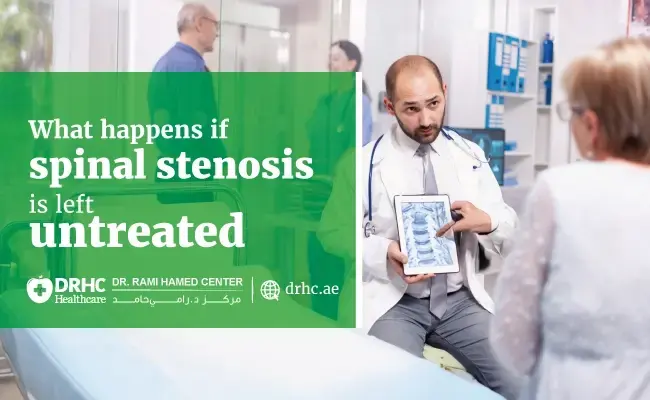
Spondylolisthesis —a condition where one vertebra slips forward over another—can start with mild back discomfort and progress silently if left untreated. Many people in Dubai and around the world delay seeking care, often hoping that the pain will go away on its own. But when spondylolisthesis goes unmanaged, it can lead to more serious complications, including permanent nerve damage.
At Dr. Rami Hamed Center (DRHC) in Dubai, we aim to help you understand your condition, ease your concerns, and guide you toward the right care before it's too late.
What Is Spondylolisthesis?
Spondylolisthesis occurs when one bone in your spine (a vertebra) slips forward over the bone beneath it. This shift can create pressure on nearby spinal nerves and even the spinal cord, especially in more advanced cases. The condition may result from age-related wear (degenerative spondylolisthesis), a birth defect, or an injury.
Some people may not experience symptoms at first. But as the condition worsens, it can interfere with your ability to walk, work, or enjoy daily life.
The Silent Progression: How Nerve Damage Develops
1. Nerve Compression from Vertebral Slippage
As the vertebra slips further, it narrows the space where nerves exit the spine. This narrowing is known as foraminal stenosis. Over time, constant pressure on the nerves may cause:
- Chronic lower back pain
- Pain radiating down the legs (sciatica)
- Tingling or numbness in the feet or toes
- Muscle weakness in the lower limbs
2. Spinal Cord Involvement
In rare and severe cases, the spinal cord itself may become compressed, especially in high-grade spondylolisthesis. This can lead to serious neurological issues, including:
- Loss of bladder or bowel control
- Severe motor weakness
- Permanent nerve damage
The longer the compression continues, the higher the risk of long-term or irreversible damage.
Why Early Treatment Matters
Many patients worry about undergoing spine surgery, and that’s completely understandable. However, not treating spondylolisthesis may eventually limit your options, especially if nerve damage progresses.
What Are the Symptoms That Shouldn’t Be Ignored?
While some discomfort can come and go, the following signs may indicate that spondylolisthesis is worsening:
- Persistent back pain that doesn’t improve with rest
- Leg pain or tingling that worsens when standing or walking
- Difficulty controlling bladder or bowel movements
- Progressive weakness or numbness in one or both legs
If you notice any of these symptoms, it's important to seek professional evaluation. At DRHC Dubai, our spine specialists use advanced imaging and diagnostics to assess your condition with precision and care.
Treatment Options at DRHC Dubai
Non-Surgical Care
For mild to moderate cases, we often begin with conservative treatments such as:
- Physical therapy to improve core strength and spine stability
- Anti-inflammatory medications for pain relief
- Epidural steroid injections to reduce nerve inflammation
These approaches can significantly relieve symptoms and slow disease progression, especially when started early.
Surgical Options (If Needed)
When non-surgical treatment fails or nerve compression is severe, spine surgery may be recommended. At DRHC, our minimally invasive techniques are designed to:
- Stabilize the spine
- Relieve pressure on nerves
- Correct spinal alignment
We understand that the idea of surgery can be overwhelming, but we’re here to answer your questions, explain the risks and benefits, and support you every step of the way.
Explore Our Related Blogs
- How spine surgery relieves nerve compression and restores function
- How a herniated disc can lead to sciatica
- How spinal stenosis causes neurogenic claudication
- What causes spinal cord compression in cervical spondylosis
Common Patient Questions Answered
Is spondylolisthesis always painful?
Not always. Some people have mild slippage with no symptoms, while others develop significant pain or nerve-related issues over time.
Can I avoid surgery completely?
Many patients improve with non-surgical treatment. However, delaying treatment in more severe cases increases the risk of nerve damage and may eventually require surgical intervention.
How do I know if I’m at risk for nerve damage?
If you're experiencing leg numbness, weakness, or changes in bladder or bowel control, it’s crucial to get evaluated right away.
How long is recovery after surgery?
Recovery depends on the type of surgery and your overall health. Minimally invasive techniques often lead to faster healing, and our team at DRHC provides a complete recovery plan tailored to your needs.
Take Action Before It’s Too Late
Untreated spondylolisthesis doesn’t just cause back pain—it can change the way you live your life. Early evaluation and treatment at Dr. Rami Hamed Center in Dubai can help protect your nerves, relieve your symptoms, and restore your quality of life.
If you’re experiencing ongoing back or leg pain—or you're simply unsure whether your symptoms are serious—don’t wait. We’re here to help you find answers and feel confident in your care.
Dr. Rami Hamed
Consultant Spine & Orthopedic Surgeon
Founder, DRHC – Dubai Healthcare City
📞 +971 4 279 8800
🌐 www.drhc.ae
📍 Dubai Healthcare City, Building 52
Topic: orthopedic Spine Surgery




.jpg)




Leave a comment